
These photos were taken by Dean Fernandez. Credit: US Forest Service, Apache Sitgreaves National Forest.

News and opinion about wildland fire
Who KNEW the U.S. Forest Service maintained a web site for an old-time string band made up of USFS employees. If you never had the pleasure (?) of visiting the Fiddlin’ Foresters web site, well, you never will, because it’s history. It was highlighted by President Obama in a video about cutting waste, and now it does not exist. The site was HERE, now it’s gone. And THIS is what it used to look like, thanks to the Waybackmachine.
The President said “I’ll put their music on my iPod, but I’m not paying for their web site”.

From the White House’s web site, here is the part about cutting the number of web sites:
As one of the campaign’s first steps, the Administration will be targeting duplication and waste among federal websites. There are almost 2,000 separate websites across the Federal Government. With so many separate sites, Americans often do not know where to turn for information. The Administration will immediately put a halt to the creation of new websites. The Administration will also shutdown or consolidate 25% of the 2000 sites over the next few months and set a goal of cutting the number of separate, stand alone sites in half over the next year.
In the video below, the part about the USFS’ Fiddlin’ Foresters begins at about 1:35.
Maybe the $25 or $50 dollars that would have been spent on the U.S. Forest Service’s Fiddlin’ Foresters web site can go toward buying a new fleet of purpose-built air tankers.
Thanks Ken
Update at 4:45 p.m. MT, June 14, 2011: We posted more current information HERE.
============
Update at 4:00 p.m. MT, June 13, 2011: added a map of the Track fire.
=============
Update at 2:54 p.m. MT, June 13, 2011: added info about the DC-10.
=============
Update at 2:46 p.m. MT, June 13, 2011: added information about the weather forecast for the Raton area.
==============
Update at 1:32 p.m. MT, June 13, 2011: added new information about the fire from New Mexico Fire Information.
===============

A New Mexico Department of Transportation traffic camera has images that are refreshed several times a minute of the Track fire near Raton pass in northeast New Mexico
You can see it at the NM DOT site. Click on “Cameras and Message Signs”, then click the box next to “Statewide Cameras”. Then click the camera icon that appears in the upper-right of the map by Raton.
Here is a link to another web cam. Click “Time-Lapse”.
Dan Ware, Info officer for the NM State Forestry, tweeted at about 2:35 p.m. that the estimated size of the fire was 6,000 acres and that the DC-10 air tanker was being used on the fire.
The weather forecast for Raton could contribute to the fire getting quite a bit larger. It’s calling for winds Monday afternoon of 22 mph gusting to 32 mph, 90 degrees, and single-digit humidities.

More information about the fire from New Mexico Fire Information, at 1:30 p.m. June 13, 2011:
=================================
Incident Name: Track
Start Date & Time: 6/12/2011 11:48
Start Location: West of Interstate 25 in Raton Pass – 36 55 12.6 104 27 20.29
Cause of Fire: unknown
Area Vegetation: pp/pj/oak brush
Acres Burned: 2,700 acres (estimated)
Ownership(s): private
Structures Threatened: yes
Structures Burned: none confirmed
Evacuations (Y or N & #): yes, current evacuation for homes and businesses on the north side of Raton, north of I-25, and north of County Road 72, Sugarite State Park
Situation: Fire activity has increased substantially since early this morning. Air tankers are being used in the areas west of Raton with good results, but there is still a lot of smoke visible as the fire burns through thick vegetation. Priority areas for protection continue to be the Raton watershed and residential areas.
I-25 remains closed between Raton and Trinidad, CO, indefinitely, as there is active, uncontained fire on either side of the interstate. State Police are diverting traffic east on Highway 64 to Capulin, north through Folsom into Colorado and then west on Highway 160 north of Branson, CO.
Power was out to Raton late this morning, as crews transferred power transmission from a threatened power line to another Tri-State line not threatened by the fire. Power should be restored shortly.
Approximately 200 structures, both residential and commercial, continue to be threatened at this time.
The fire started on the west side of Interstate 25 yesterday afternoon and jumped to the east side earlier making a run toward Barlett Mesa and toward Colorado.
A Type 2 incident management team will take over command of the fire this afternoon.
Update at 7:45 p.m. MT, June 13, 2011:
The Apache-Sitgreaves National Forest Twitter account just sent out a link to an official Wallow fire update that reduces the acreage from this morning’s 452,155 to 448,620. But now that tweet and the latter document have apparently been deleted. InciWeb still says 454,155 acres. (Update: the June 13, 6:00 p.m. document was deleted and later restored with a modified acreage of 454,155.)
===========================
Update at 11:50 a.m. MT, June 13, 2011:
Today’s 8:00 a.m. update from the incident management team was released at about 10:20 a.m on InciWeb.
===========================
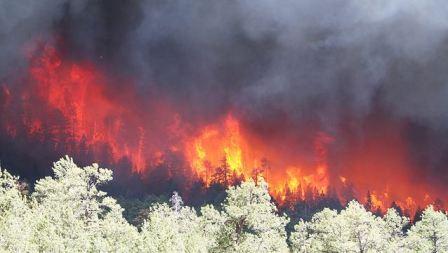
Firefighters on the Wallow fire in eastern Arizona and western New Mexico continued making progress on the fire Sunday. The fire grew by 9,000 acres but the containment percentage also grew, from 6% to 10%. There is conflicting information on the fire’s InciWeb site and there has been no official email update from the incident management team since Saturday morning. However, the Twitter account of the Area Command Team that is supervising four incident management teams (Reinarz, Pendleton, Hughes and Ponci) Tweeted at 9:03 a.m. Monday: “Wallow fire at 452,155 acres with 10% containment”. But at least the wildland fire agencies seem to have InciWeb working again this morning, which is an improvement over the frequent outages over the last few days. The national Situation Report has also been intermittent recently, but is working today.
Sunday night at 11:16 p.m. the backfire or burnout in New Mexico on the east side of the fire was in about the same place as it was Saturday night, having progressed approximately six miles, most of it along Jenkin Creek Road and Forest Road 220, working southeast toward the community of Luna, NM. It was still within about two miles of Luna.
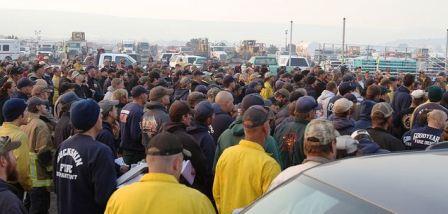
A small portion of the main fire south of Highway 180 has crossed into New Mexico where the Blue River intersects the AZ/NM state line.
There was no major movement of the fire on the north, west, or south sides on Sunday. The fire continued to spread slowly on the south side and there were some areas on the east side south of Greer where the fire was very active.
Azcentral.com has a very cool interactive progression map of the Wallow fire. Unfortunately it is only current through June 10.
We did not hear anything about the DC-10 Very Large Air Tanker being used on the Wallow fire yesterday. There was an unconfirmed report on Facebook of it being requested to drop on a 1,600-acre fire in New Mexico near Raton Pass.
Below is a 3-D map of the east side of the Wallow fire. Click on it to see a larger version.
Continue reading “Wallow fire update, June 13”

The Washington post pointed out in an article on Sunday that the 18 large air tankers on contract in the U.S. have an average age of about 50 years and are overdue for replacement.
The article hits on most of the same issues that we have written about at Wildfire Today on two occasions:
When two large air tankers crashed in 2002, killing five crew members, the U.S. Forest Service culled the fleet of 44 large air tankers, weeding out the most vulnerable, and the ones most susceptible to metal fatigue and other issues that compromised safety when flying in mountainous terrain, in and out of canyons. Today there are only about 18 large air tankers on exclusive use contracts, a 60% reduction from 2002. And this year the USFS is refusing to offer exclusive use contracts for Very Large Air Tankers, the DC-10 and 747.
In the nine years since the 2002 crashes and reduction in force of the air tanker fleet, the USFS has commissioned multiple reports about how to modernize the fleet. Deadlines have passed with little or no action taking place that would actually replace the aircraft.
Two private air tanker operators, Neptune and Menden, are both engaged in projects to retrofit 4-engine jet airliners, BAe-146 aircraft that are much younger than the the 50-year old air tankers now flying. Neither of them have passed muster with the Interagency Air Tanker board and have yet to drop on a fire.
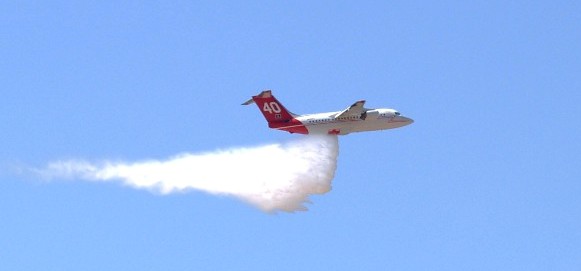
The USFS is saying that later this year they will ask Congress for the funding to either buy new air tankers, or pay someone to retrofit used aircraft.
Here is an excerpt from the Washington Post article:
…Tom Harbour, national fire director for the Forest Service, said the secretary of agriculture will take a funding plan to Congress in August.
“We have good data on effectiveness and use,” Harbour said. “There’s always more data that we can collect to make a more compelling case.”
But why has it taken nine years since the 2002 crashes?
“Identifying the right air tankers and processing them is a very complex issue,” said Jeff Jahnke, Colorado’s state forester and president of the National Association of State Foresters, who said the criticism is unfair. The Forest Service is made up of “top performers, very science-focused, one of the leading incident managers in the world,” when it comes to wildfires, he said.
A source in the agency who asked not to be identified, fearing the loss of his job, said the Forest Service is trying to decide between two approaches: buying air tankers outright from aircraft manufacturers or requesting bids from aviation companies that rebuild airplanes, mostly from a Defense Department “bone yard” where aging military aircraft are placed after a specified number of flights.
The service could buy planes from several companies for about $2.5 billion, but it would be responsible for providing maintenance crews and pilots, experts said. The service could also request bids for large contracts with specifications to provide newer-model planes.
Manufacturers say they are prepared to provide whatever the government wants. Bombardier, a Canadian company, has repeatedly sought to sell its CL-415, built in 1991, to the United States. The turbo-engine plane can swoop to a water source, scoop 1,600 gallons and deliver it to a fire.
Bombardier has sold 155 planes worldwide, including 69 of the CL-415s to Italy, Spain, Greece and France for about $35 million each, said Derek Gilmour, vice president of sales and administration.
Thanks Ken
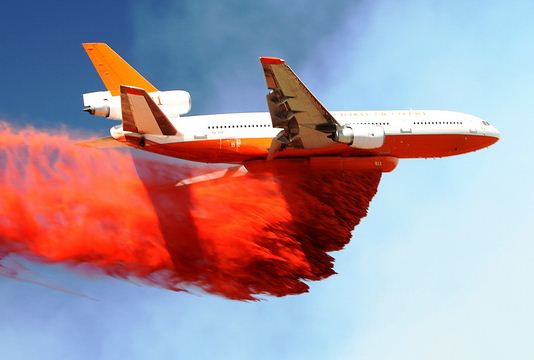
Air Tanker 911, a DC-10 that can carry up to 11,000 gallons of retardant, made two sorties Saturday to the Wallow fire in eastern Arizona.
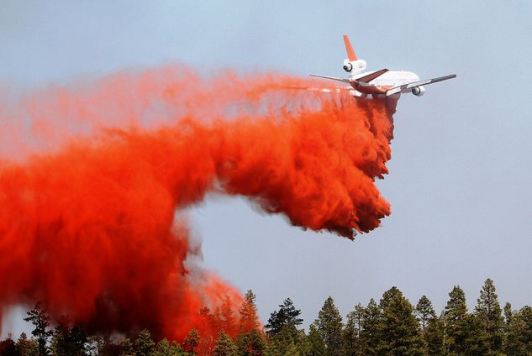
And as a bonus, since you scrolled down this far, below are two more photos (non-DC-10) taken by Jason Coil on June 8, 2011. Credit: US Forest Service, Apache-Sitgreaves National Forest.
Continue reading “Photos: DC-10 drops retardant on the Wallow fire”